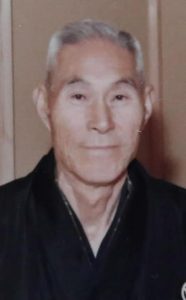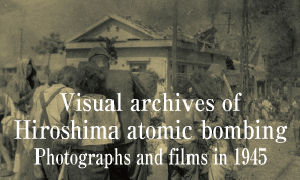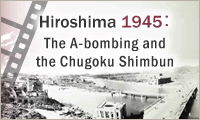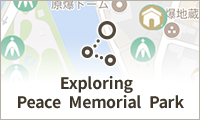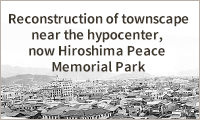Documenting Hiroshima of 1945: Late September, only one survivor at Fuel Hall
Sep. 21, 2024
by Maho Yamamoto, Staff Writer
In late September 1945, the Fuel Hall, located around 170 meters from the hypocenter, had largely retained its shape, despite its partially destroyed roof and walls. The ferro-concrete hall, composed of three stories aboveground and a one-floor basement, was originally built as the Taishoya Kimono Shop, in the area of Nakajima-honmachi, a bustling shopping district before the atomic bombing that ultimately became the present-day Peace Memorial Park (in Hiroshima’s Naka Ward). At the time the bomb was dropped, the building was being utilized as a head office for the Hiroshima Prefectural Fuel Rationing Union.
On August 6, 37 employees of the union were at work in the office. As Eizo Nomura, 47 at the time, was looking for documents in the basement, he heard a huge explosion.
“Immediately, the lights went off, turning everything completely dark. At the same time, something hard and sharp like gravel hit two or three places on my body. I thought, ‘that hurt,’ and touched my head, only to find something sticky running down. It was blood!” wrote Mr. Nomura in his personal account titled Bakushin ni Abiru (in English, ‘Exposed at hypocenter’), published in 1950.
Going up the stairs in the darkness, Mr. Nomura’s feet bumped into someone’s body on the floor. He put his arms around and lifted up the person, but they appeared to already be dead. Outside the building, he found that the Prefectural Industrial Promotion Hall (present-day A-bomb Dome) on the opposite side of the Motoyasu River was on fire, which was quickly gaining strength. Finally, he experienced a heavy rain that made him shiver.
He was able to flee to an area outside the city, but his body was ravaged by the large dose of radiation to which he had been exposed nearly directly beneath the A-bomb’s detonation. On September 1, he broke out in a fever. According to his account, “I had hemorrhagic spotting in five or six places on my body. My gums went rotten, and severe diarrhea continued for more than 10 days. With that, my broken body was terribly weakened.” Physicians had no idea about how to treat him and his family had given up hope for his survival.
Nevertheless, he miraculously recovered. Of the 37 people at work in the hall that day, he was the only one to survive. Seven other people were able to escape from the building, with one woman among them surviving about two weeks but dying on August 23, after vomiting a large amount of blood.
The story of Mr. Nomura’s survival in the bombing is introduced at the Rest House, the successor to the Fuel Hall. He died in 1982 at the age of 84. In an autobiography he wrote at the end of his life, he sounded a warning about the nuclear arms race. “In the next world war, the chance of survival will certainly be less than one-in-37.”
(Originally published on September 21, 2024)
In late September 1945, the Fuel Hall, located around 170 meters from the hypocenter, had largely retained its shape, despite its partially destroyed roof and walls. The ferro-concrete hall, composed of three stories aboveground and a one-floor basement, was originally built as the Taishoya Kimono Shop, in the area of Nakajima-honmachi, a bustling shopping district before the atomic bombing that ultimately became the present-day Peace Memorial Park (in Hiroshima’s Naka Ward). At the time the bomb was dropped, the building was being utilized as a head office for the Hiroshima Prefectural Fuel Rationing Union.
On August 6, 37 employees of the union were at work in the office. As Eizo Nomura, 47 at the time, was looking for documents in the basement, he heard a huge explosion.
“Immediately, the lights went off, turning everything completely dark. At the same time, something hard and sharp like gravel hit two or three places on my body. I thought, ‘that hurt,’ and touched my head, only to find something sticky running down. It was blood!” wrote Mr. Nomura in his personal account titled Bakushin ni Abiru (in English, ‘Exposed at hypocenter’), published in 1950.
Going up the stairs in the darkness, Mr. Nomura’s feet bumped into someone’s body on the floor. He put his arms around and lifted up the person, but they appeared to already be dead. Outside the building, he found that the Prefectural Industrial Promotion Hall (present-day A-bomb Dome) on the opposite side of the Motoyasu River was on fire, which was quickly gaining strength. Finally, he experienced a heavy rain that made him shiver.
He was able to flee to an area outside the city, but his body was ravaged by the large dose of radiation to which he had been exposed nearly directly beneath the A-bomb’s detonation. On September 1, he broke out in a fever. According to his account, “I had hemorrhagic spotting in five or six places on my body. My gums went rotten, and severe diarrhea continued for more than 10 days. With that, my broken body was terribly weakened.” Physicians had no idea about how to treat him and his family had given up hope for his survival.
Nevertheless, he miraculously recovered. Of the 37 people at work in the hall that day, he was the only one to survive. Seven other people were able to escape from the building, with one woman among them surviving about two weeks but dying on August 23, after vomiting a large amount of blood.
The story of Mr. Nomura’s survival in the bombing is introduced at the Rest House, the successor to the Fuel Hall. He died in 1982 at the age of 84. In an autobiography he wrote at the end of his life, he sounded a warning about the nuclear arms race. “In the next world war, the chance of survival will certainly be less than one-in-37.”
(Originally published on September 21, 2024)

